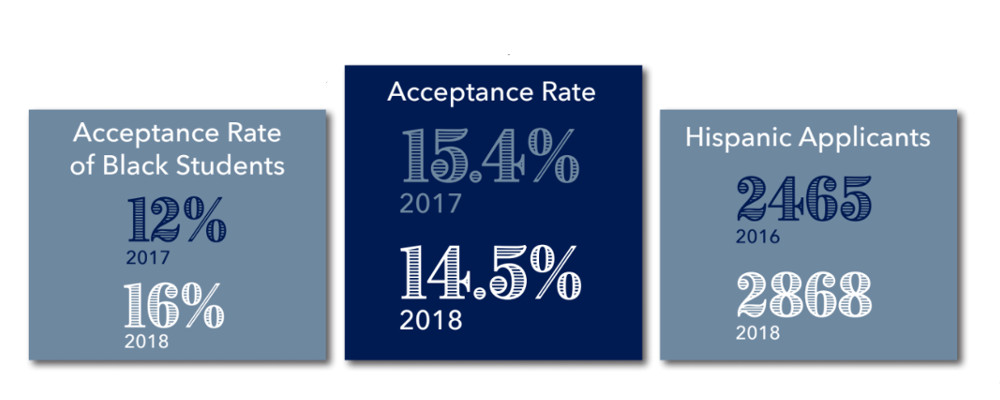The students who opened their Georgetown acceptance letters last week are part of the most diverse group the university has admitted to date. According to Charles Deacon (COL ’64), dean of undergraduate admissions, the prospective class of 2022 had the highest number of minority applicants and admitted students, paired with the lowest total acceptance rate, in the school’s history.
“The university is in a much different place today compared to 20, 30, or 40 years ago,” Deacon said, referring to an increasingly diverse student body.
Out of a record-high 22,897 applicants, the university accepted 14.5 percent, compared to last year’s rate of 15.4 percent. Deacon said that compared to previous years, this applicant pool was more diverse. For example, applications from black students increased by 30 percent from 2013 to 2018.
He also emphasized the increase in the number of multiracial students admitted to the university as another example of this larger trend. However, Deacon said this increase brings a new set of challenges. He noted that the university needs to improve how it counts multiracial students in order to properly report the makeup of the student body.
As Deacon explained, the current census groups many different numbers for multiracial applicants under one group labeled “Hispanic.” “The numbers become a hard thing to deal with,” Deacon said, when referring to the challenge of keeping records of people who are multiracial.
Georgetown’s proportions of admitted minority students are still close to national numbers, and Deacon highlighted the growing trend in applicants who are minorities. He said he is confident that the rising diversity of applicants will continue to increase the ethnic and cultural mix of students on campus in the next five years.
Despite these demographic changes, Georgetown still struggles in some ways to attract a diverse applicant pool, Deacon said.
“As a Catholic university, we might have more Hispanic and white [applicants], but much fewer black and foreign national [applicants],” Deacon said. Generally, the proportion of African-Americans and foreign nationals who are Catholic is lower than that of white and Hispanic people.
A new SAT exam format in 2016 has resulted in higher average scores across the country, and more students therefore wish to apply to more competitive schools. Deacon said that for the admissions department, this means that there must be a greater focus on holistically viewing each person’s application than previous years, with less weight placed on exam scores.
Georgetown’s application also includes minor changes this year. Applicants can now select “other” for their gender identity, rather than choosing between male and female. Additionally, applicants are no longer required to provide their Social Security number, which Deacon said was in response to increased scrutiny on DACA recipients and undocumented university students.
However, even with the increased diversity at Georgetown, some believe there is still work to be done. Emily Kaye (COL ’18), student board president of the Georgetown Scholarship Program (GSP), a scholarship and mentoring program for low-income students since 2004, said that the comfort of minority students at Georgetown is still an important consideration. “As long as the university remains a predominantly white and wealthy institution, low-income students and/or students of color will face issues of feeling that they belong on campus,” Kaye wrote in an email to the Voice. “I hope that while the University maintains its commitment to bringing diverse students to Georgetown, it increases the resources necessary to get those students through Georgetown as well.”
Kaye noted that increasing these resources for groups such as GSP and the Community Scholars Program, which serve select first-generation and low-income college students, is also crucial.
“GSP currently has fewer than 1,000 square feet of space to support over 650 students,” she wrote. “Sometimes when I have gone to see our wellness advisor about private issues there have been no closed-door offices available to speak in.”
Deacon said that in order to reach out to minority students around the country, Georgetown is participating with Harvard University, Stanford University, Duke University, and the University of Pennsylvania in an outreach program called “Exploring College Options.”
The outreach initiative is composed of 140 different programs, which will host events in major cities in all 50 states to reach out to prospective students. Deacon noted that reaching out to different national groups, such as the Cristo Rey Jesuit network and the Knowledge Is Power Program (KIPP), networks of free college-preparatory schools in under-resourced communities, is also key.
“We are trying to reach groups that are national, and we try to network to places that we think are reaching further out and bringing talented people in, aiming them towards the competitive colleges and universities,” he said.
Christian Sese, the director of Hoya Saxa Weekend, a program that hosts accepted students of color on campus, said that prospective students are curious about what life is like on a traditionally white campus.
“They want to feel safe but also celebrated,” he wrote in an email to the Voice. “Our goal is to provide a small glimpse into the vibrant but challenging multicultural experience on the Hilltop.”
With trends showing the nation’s population continues to diversify, Georgetown is working to reflect these changes. Deacon believes that Georgetown is becoming more representative of the ethnic and cultural makeup of the country and will continue to do so for years to come.
Design Credit: Margaux Fontaine/The Georgetown Voice






Thank you Georgetown University for creating an inclusive environment where different cultures feel respected and valued.